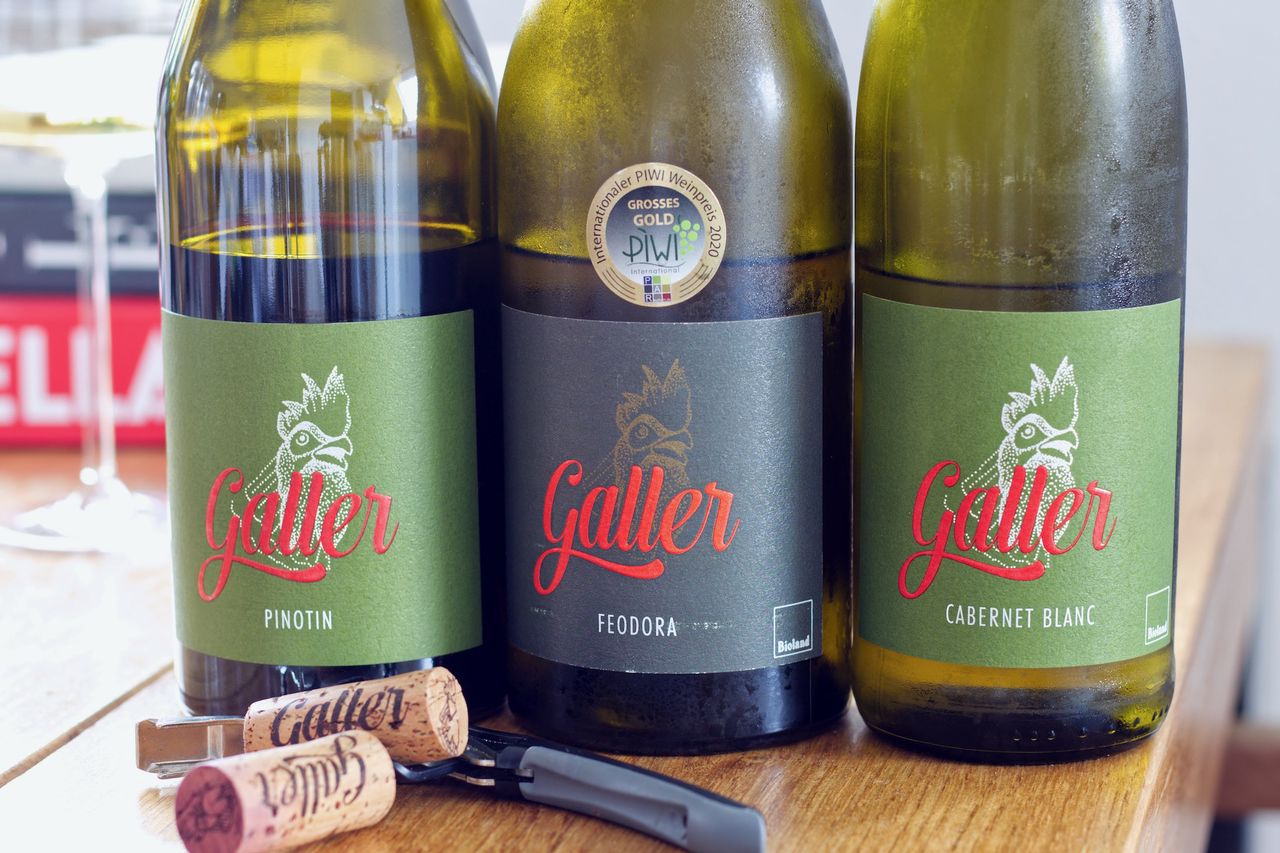Three Bottles Galler
We continue with the PiWis and drink from Galler Winery a bottle of Cabernet Blanc 2020, a bottle of Feodora 2019 and a bottle of Pinotin 2017.

One winery that kept popping up, at least for me, during my journey of discovery through the world of PiWis is the Galler Winery. Pretty far north of the Palatinate, in Kirchheim an der Weinstraße, it was only founded in 2009. Ansgar Galler and family decided here in 2012 to replant only fungus-resistant grape varieties. In the meantime, the entire portfolio has been converted to PiWis with the 2021 vintage. The range of grape varieties and quality levels is wide, in both whites and reds, and there are plenty of names to read that I’ve never heard of. We taste one of them, Pinotin from 2017, right away. There is also a bottle of Cabernet Blanc 2020 and a quality level above that a Sauvignac Feodora 2019. I have to complain directly about the bottle though. The appearance is so nice, the paper feels great, I like the design and then there is this ugly Grosses Gold sticker stuck on top. I really hope that the sales figures grow in at least the same extent, in which it drags down the appearance. On me, at least, it acts rather deterrent and that does the wine absolutely wrong.
But we start with the Cabernet Blanc. And this representative is also quite reminiscent of the fruit of Sauvignon Blanc. There’s passion fruit and gooseberry. The fruit is super fresh on the nose. There’s also peach, local pit fruit and some green notes. The wine is fruity, but not too fruity. The greenness arrives on the tongue as well. Fortunately in a dose I still like and in the mix with gooseberry and apple, this is really nice to drink. The acidity is mild and certainly doesn’t hurt anyone. This is wine that doesn’t get on anyone’s nerves, should suit the tastes of super many people but still isn’t boring. I would say that this is the perfect PiWi entry.
With a day of air, the Cabernet Blanc seems greener on the nose and has a bit of hops. Otherwise, it stays exactly as it was anyway. The better half likes it more than I do, but it fits as is and it’s not like my glass would stay full forever.
In contrast, Feodora has a hard time at first. The Sauvignac is much quieter on the nose and except for a little bit of glue, there’s not much after the expressive Cabernet Blanc. Experience says that swirling might help and it does here as well. With more air comes some exotic fruit, also reminiscent of Sauvignon Blanc, and a small note of canned fruit. You also smell a bit of wood and herbs. Still, you have to smell pretty deep into the glass to get your money’s worth. On the tongue, however, this is great from the first sip. There is also rather little fruit compared to the previous wine, but the structure and feel are really good. With even more air, the wine then also becomes more intense on the nose. It now gains in fruit and exoticism and on the tongue it becomes creamier and even more intense. It also seems almost a bit salty by now. It becomes quite clear that we are a step above the other two wines here.
The wine becomes more herbaceous overnight. The taste in particular has evolved. The complexity is great and even on the second evening, air still really does the trick. In form, Sauvignac is a grape variety to definitely keep an eye on. I think it’s really exciting because it shows how much substance you can give the grape variety. The wine simply doesn’t need this gold sticker at all. But it definitely deserves the award.
Finally, Pinotin 2017. The wine has fruit and wood on the nose. There are cherries, berries and a bit of rose. On the tongue, it has nice acidity and the tannin is present but fairly softly polished. And there’s plenty of fruit here as well. Like the Cabernet Blanc, this is a straightforward wine that should work really well with food.
Funnily enough, the Pinotin is then the wine with the most overnight evolution. For lack of space, it has not spent the night like the other two in the refrigerator but had to stay in the attic heat on the table. But that did not hurt. Quite the opposite, in fact. To the fruit and the gentle wood, the wild berries and the cherry now comes an intense floral note of violet and lilac. This suits the Pinotin really well. And for the about 12 euros that the wine costs, you don’t have to think long about buying it.